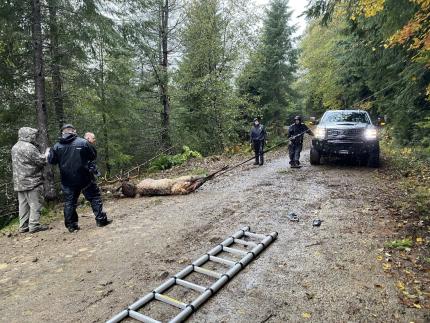Managing Wildlife Populations
Ebey Slough White-nose Syndrome Monitoring Update: District 13 Biologists completed the installation of a solar powered PIT (Passive Integrated Transponder) tag reader at a maternity bat roost in Snohomish County. This equipment will help document survivorship, colony size, and colony phenology to assess efficacy of a vaccine trial to treat bats for white-nose syndrome.


Avian Influenza Mortality Event at Lake Tye: District 13 Biologists responded to an avian mortality event at Lake Tye in Monroe, predominantly impacting cackling geese. A total of approximately 80 sick and dead cackling geese have been collected to date. Washington State Department of Wildlife (WDFW) Wildlife Program staff members collaborated with many partners including WDFW Enforcement Program, Snohomish County Parks and Recreation, WDFW Communications and Public Engagement (CAPE), and Smith-Root Inc. to collect and sample carcasses, post informational signage, conduct public outreach, and test novel methods for avian influenza detection. Biologist Licence provided multiple media interviews on the event.

Winter Forage Ecology of Trumpeter Swans Field Project: Region 4 staff members are assisting the Waterfowl Section staff members and Graduate Student Romero in a telemetry project in the Skagit and Stillaguamish river deltas that will provide valuable insight into swan foraging, ecology, and management. Capture operations will extend into December.
Providing Recreation Opportunities
Annual Game Management Unit 485 Green River Watershed Special Permit Hunts: District 12 staff members worked the annual weeklong hunts in the Green River Watershed. A huge thanks to Tacoma Water for coordinating and hosting these special hunts. Washington Department of Fish and Wildlife (WDFW) would also like to thank the Muckleshoot Indian Nation for their annual collaboration and planning to provide for both the annual citizen and tribal special hunts in October and November each year.

Conducting Business Operations and Policy
Park Use Conflicts with Wildlife – Seattle: Biologist Anderson met with City of Seattle staff members and a WDFW habitat biologist regarding proposed changes to the use of a Seattle park. The city plans to convert an open area that is currently staging trucks and other heavy equipment to a pickleball court. Originally, they planned for the area to be used for tennis courts. Seattle is currently weighing comments and concerns of the public and non-government agencies regarding the potential impacts to wildlife.
Bats and Bridges – Washington State Department of Transportaion (WSDOT): Biologist Anderson, WDFW Bat Specialist Tobin, and members of WSDOT Environment Group met to discuss partnerships that will provide for bats on transportation infrastructure. Many good thoughts and some pilot efforts were discussed. The hope is for the two agencies to partner on more projects in western Washington. The partnership between the agencies will support the conservation needs of bats while obtaining broader data on bat occurrence, type of use, and their overall activity patterns.
Providing Education and Outreach
Burke Museum Public Coyote Necropsy: Washington Department of Fish and Wildlife (WDFW) District 12 Veterinarian Haman and members of the Prugh Lab at University of Washington conducted a training necropsy on a young, but independent, coyote that was found randomly deceased in a backyard in Seattle. The animal had been in good shape and in gross exam it appeared it had just started to decline recently – perhaps having a respiratory infection. They sent out the tests for analysis.
This was not only a great opportunity for the group of biologists to learn from Dr. Haman, but it was also an opportunity for the public to see WDFW staff members at work. Several school field trip groups dropped by the large pane window of the new, public viewing lab in the museum. It provided great outreach and it was a good opportunity for the public to see lab efforts related to wildlife biology and management. Thanks again to the Prugh Lab and Dr. Haman!
